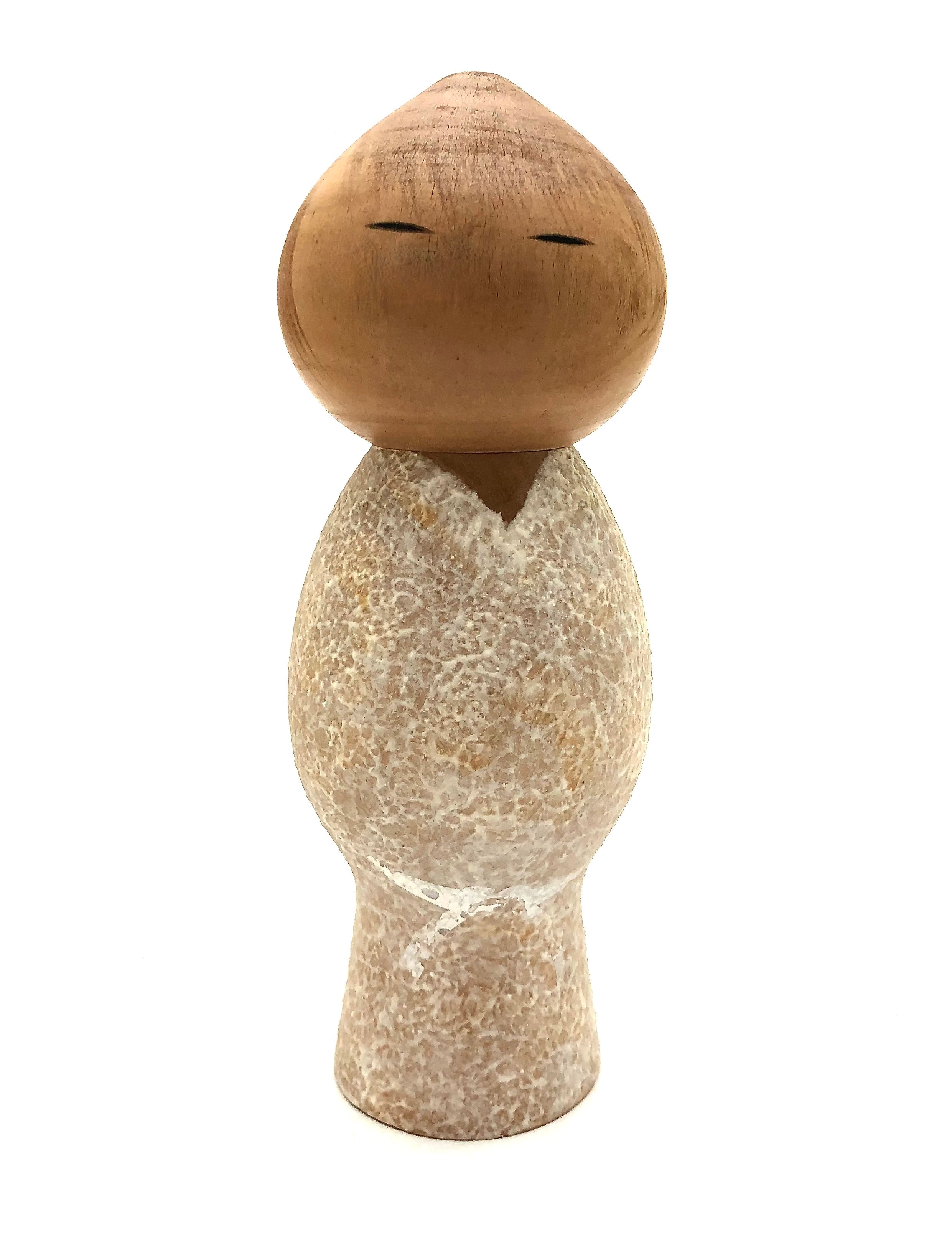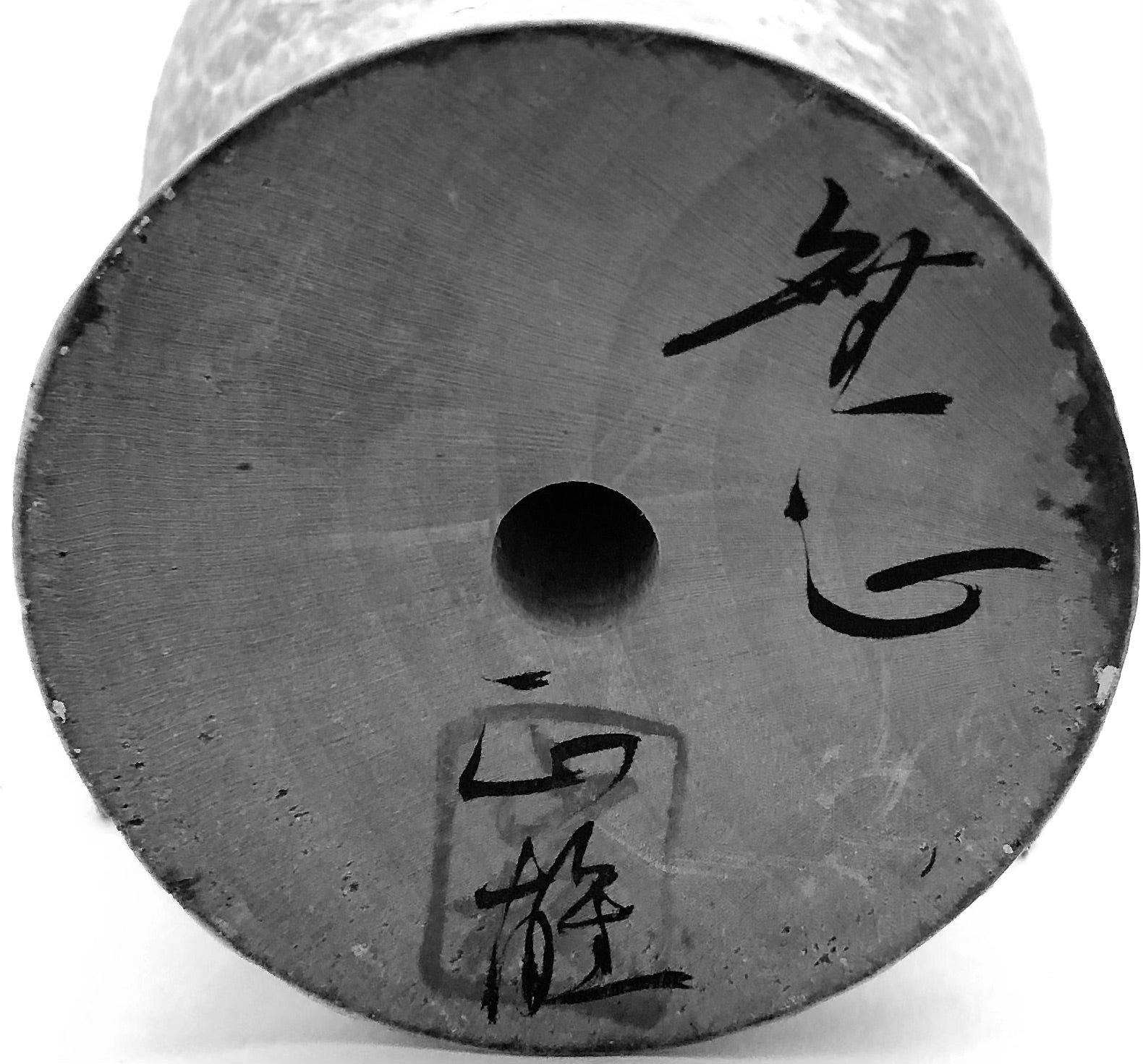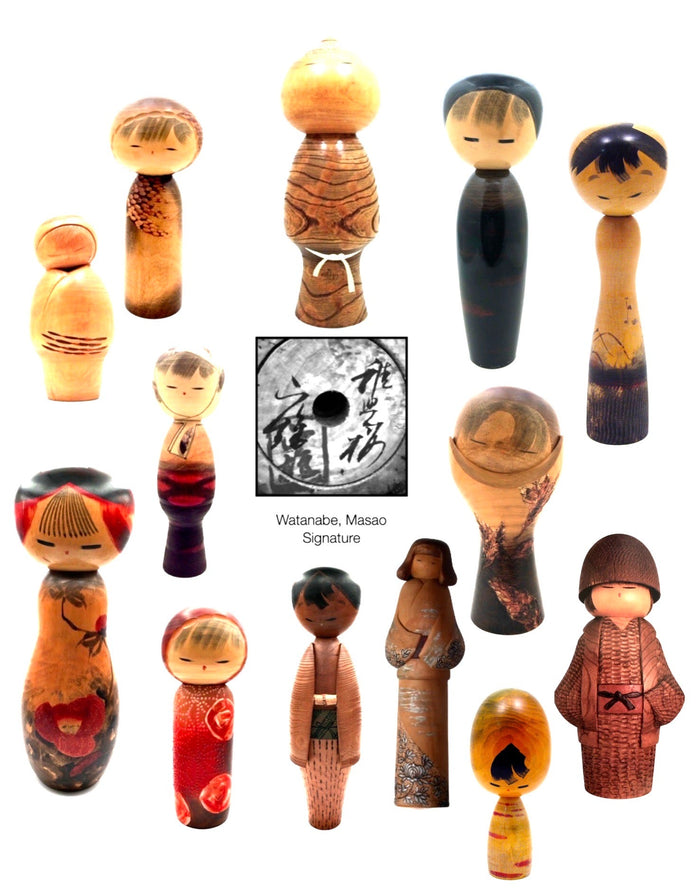

Japanese Vintage Sosaku Kokeshi entitled: ‘Mushin’ | Innocence by Masao Watanabe
Dimensions: 8-0”h
Offered is a wonderful small Kokeshi of a child referred to as Innocence. In looking at the diversity of the dolls created by Masao Watanabe, we see he was fascinated with the subject of the innocence of children’s simplicity, their lack of knowledge, and their purity, not yet spoiled by mundane affairs. His dolls of children suggest that innocence is to be taken as the promise of a renewal of the world's children.
As shown in this beautiful figure he focuses on the conical-shaped head which has the shape of a chestnut, with light whips of brown hair irregularly falling over the skull with slanted eyes with no eyelid, nose, or mouth. Its body is covered, in this case, with a white Yukata or in Japanese, yo͝oˈkädə, (a light cotton kimono, worn in casual settings such as at play, summer festivals, and to nearby bathhouses). To finish off the look he added a white painted sash tied low on the bulbous-shaped figure. The rendering of the garment design is common for this particular series for which the raised motif resembles Shibori, a type of tie-dyeing that gives texture to the garment. The piece is finished with either a type of natural or colored candle wax, (Rosoku no ro). The piece has the artist's script signature and a red personal stamp on the bottom of the figure.
Condition: Excellent with no imperfections, no color loss or fading. This is a unique, unusual, and a perfect doll for the collector of Watanabe-san’s work in the Japanese Kokeshi folk art genre.
Additional Information: Masao Watanabe | 1917-2007 (89)
Born in Fukushima, Watanabe-san studied under Traditional Yajirou Master Sato, Tatsuo of Miyagi Prefecture. After relocation to America, Masao Watanabe, (Nisei male), was incarcerated at the Puyallup Assembly Center, Washington, and transferred to the Minidoka internment camp, Idaho during World War II. Arguably, the most popular and prolific of the 20th/c Sosaku Kokeshi artists, he began his craft in the early 1950s. He is famous for not only minimally carving beautiful woods but also for his use of gessoed surfaces and lacquer. A multiple award winner in Kokeshi competitions around the world, his works are permanently exhibited at the Nuremberg Toy Museum in Germany.

Artisan
Woodworker: Watanabe, Masao
1917-2007
Biographical History:
Watanabe-san is considered to be one of the greatest Sosaku Kokeshi artists in all of Japan. Born in Fukushima, Watanabe-san studied under Traditional Yajirou Master Sato, Tatsuo of Miyagi Prefecture. Arguably, the most popular and prolific of the 20th/c Sosaku Kokeshi artists, he began his craft in the early 1950s. His most famous Kokeshi themes are that of ‘innocence’ (Mushin), and his doll entitled: Chigo Zakura (Cherry Blossom Child) won the Minister’s Award and was presented to the Beatles in 1965, after their appearance in Japan with Sir Joseph Lockwood, Chairman of EMI Record Distributors, England. A multiple award winner from 1963-1981 in Kokeshi competitions around the world (Prime Minister's prizes for the works of "Chigozskura" in 1963 and "Shojo" in 1981), along with numerous prizes by the Modern Kokeshi Artist Association and JETRO. He held two exhibitions in Japan and was exempt from the examination of the All Japan Kokeshi Contest, a Member of the Nippon Kokeshi Artistic Handicraft Association. His works are permanently exhibited at the Nuremberg Toy Museum in Germany.

Collector's note – descriptive qualities, standard characteristics & ornamentation styles:
Of all the Kokeshi the emphasis is on the color of the natural wood and texture, and his diversity of form is the most recognizable characteristic of his dolls. The representation of clothing is seen in the use of the diverse rendering of Kimono, Yukata, and Haori complemented by the painted details that are common throughout his works. Several dolls not only show wonderful color rendition as well as textured/ raised applications resembling Shibori, a type of tie-dyeing that gives texture to the garment. He also prominently features the rose and camellia as a central motif along with extremely expressive eyes throughout the range of ages represented in his works.
Signature Research:
We heard from our colleague at Soulportals KokeshiVillage, a website researching vintage and contemporary Kokeshi artists and signatures. It was brought to our attention that Watanabe subcontracted an artist named Sato Norio to reproduce large numbers of his Kokeshi in the 1960s because of an enormous number of orders for his award-winning design Chigazokaura. Watanabe's signature for pieces designed and crafted by him is shown on this page celebrating a number of his award-winning dolls. Nario's versions were entitled Plum Grove and approved/attributed to Masao but not crafted by him.
Explore & Learn More about Woodworker: Watanabe, Masao